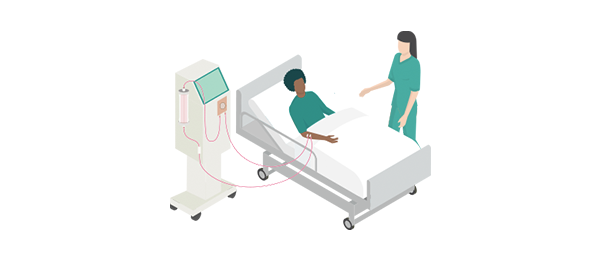Peritoneal dialysis (PD) at home
If you are starting dialysis, peritoneal dialysis (PD) may be one of the treatment options available. Learn more about PD at home.
What is peritoneal dialysis (PD)?
Peritoneal dialysis is a treatment that uses the lining of your abdomen – called the peritoneal membrane – to remove waste products from your blood. It is usually done at home and can even be carried out while sleeping or travelling. It might be the right therapy for you if you value mobility or a flexible treatment schedule.

How is PD performed?
During PD, a fluid called dialysis solution (or dialysate) passes into your abdomen through a catheter. This catheter is inserted into your abdomen in a surgical procedure prior to starting PD. Once the dialysis fluid has flowed into your abdomen, it stays there, cleaning your blood by absorbing any waste and excess fluid. After a prescribed period of time (1 to 6 hours), the dialysis solution containing the waste and excess fluid from your body is drained out of your abdomen through your catheter. This entire process is called an exchange.
APD VS CAPD
There are two types of peritoneal dialysis (PD): automated peritoneal dialysis (APD) and continuous ambulatory peritoneal dialysis (CAPD).

Automated peritoneal dialysis (APD)
APD requires a machine to deliver the dialysis fluid into the abdomen.
APD usually takes place at night when a machine is connected to your PD catheter. While you are sleeping, the machine drains used dialysis solution and supplies clean dialysis solution. You can then disconnect from the equipment when you wake up and resume normal activities.

Continuous ambulatory peritoneal dialysis (CAPD)
CAPD is a treatment that uses gravity to fill and drain dialysis solution from your abdomen.
CAPD exchanges are usually done 3 to 4 times a day, mainly upon waking, before lunch and dinner, and at bedtime. During a CAPD exchange, dialysis fluid replacement is performed manually by you or your caregiver during the day. During each replacement, it may take up to 30 minutes to drain the used dialysis solution from the abdomen and fill the abdomen with a new bag of fresh dialysis solution. You can then resume regular daily activities until the next exchange.

How do I prepare for peritoneal dialysis?
Performing PD at home is quite a manageable process. With proper training, almost everybody can perform PD. This will usually require about 5 days of training.
After your catheter is placed, it needs to heal prior to being used. Depending on the method used to insert the catheter and your hospital’s policy, it may need to heal for anywhere between 3 and 14 days before being used.
What are the benefits of PD?
What are the side effects of PD?
What are the potential complications of PD?
How long can I live on dialysis?
Survival on dialysis varies widely according to the age at which a person commences therapy. For example, the median survival for patients aged 25-44 at the time of commencing dialysis in the period 2011-2020 was 8.8 years in Australia compared to 3.6 years for patients aged 75-84 at the time of starting dialysis.1
Subscribe to My Kidney Journey Newsletter
Sign up now to receive exclusive content on kidney disease, treatment options, lifestyle tips and inspiring patient stories.
Where to go next?

Continuous ambulatory peritoneal dialysis (CAPD)
CAPD can be performed at work, home or during travel.

In-centre haemodialysis (In-centre HD)
You may prefer to receive dialysis at a hospital or treatment centre near you with ICHD.

